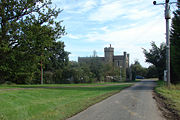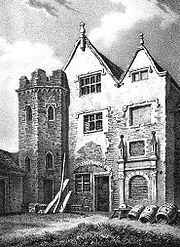
Francis Gawdy
Encyclopedia

Baptism
In Christianity, baptism is for the majority the rite of admission , almost invariably with the use of water, into the Christian Church generally and also membership of a particular church tradition...
Thomas Gawdy, as were his two older half-brothers. Francis then had his name changed at his Confirmation, establishing legal precedent that a name given at baptism could be changed at confirmation. He may have studied at Trinity Hall, Cambridge
Trinity Hall, Cambridge
Trinity Hall is a constituent college of the University of Cambridge, England. It is the fifth-oldest college of the university, having been founded in 1350 by William Bateman, Bishop of Norwich.- Foundation :...
, matriculating in 1545, and was called to the bar at Inner Temple
Inner Temple
The Honourable Society of the Inner Temple, commonly known as Inner Temple, is one of the four Inns of Court in London. To be called to the Bar and practise as a barrister in England and Wales, an individual must belong to one of these Inns...
in 1549, becoming a bencher in 1558 and treasurer in 1571. He served as a reader at Lyon's Inn
Lyon's Inn
Lyon's Inn was one of the Inns of Chancery attached to Inner Temple. Founded some time during or before the reign of Henry V, the Inn educated lawyers including Edward Coke and John Selden, although it was never one of the larger Inns...
in 1561 and at Inner Temple in 1566 and 1571. He had an unremarkable parliamentary career, elected to represent Morpeth
Morpeth (UK Parliament constituency)
Morpeth was a borough constituency centred on the town of Morpeth in Northumberland represented in the House of Commons of the Parliament of England until 1707, the Parliament of Great Britain from 1707 to 1800, and then the Parliament of the United Kingdom....
for the 1571 election, but focused mainly on his legal career. He was made Serjeant-at-law
Serjeant-at-law
The Serjeants-at-Law was an order of barristers at the English bar. The position of Serjeant-at-Law , or Sergeant-Counter, was centuries old; there are writs dating to 1300 which identify them as descended from figures in France prior to the Norman Conquest...
in 1577 and Queen's Serjeant in 1582, and as Queen's Serjeant opened the prosecution against Mary, Queen of Scots. In 1563 he married Elizabeth Coningsby, who was described by Sir Henry Spelman
Henry Spelman
Sir Henry Spelman was an English antiquary, noted for his detailed collections of medieval records, in particular of church councils.-Life:...
as

King's Lynn
King's Lynn is a sea port and market town in the ceremonial county of Norfolk in the East of England. It is situated north of London and west of Norwich. The population of the town is 42,800....
Gawdy succeeded his elder brother, the middle Thomas Gawdy
Thomas Gawdy
Sir Thomas Gawdy SL was a British justice and Member of Parliament.He was the second of three sons of Thomas Gawdy, all by different wives and all baptised Thomas The mother of this Thomas was Anne Bennett...
, as a justice of the King's Bench
King's Bench
The Queen's Bench is the superior court in a number of jurisdictions within some of the Commonwealth realms...
in 1588, and took part in many of the major trials of this period, including that of Sir Walter Raleigh
Walter Raleigh
Sir Walter Raleigh was an English aristocrat, writer, poet, soldier, courtier, spy, and explorer. He is also well known for popularising tobacco in England....
in 1603, and was knighted the same year. Gawdy apparently expected to succeed Sir William Peryam
Sir William Peryam
Sir William Peryam was an English judge who, in 1593, rose to the top position of Lord Chief Baron of the Exchequer and was knighted by Queen Elizabeth I.-Life:...
as Lord Chief Baron of the Exchequer
Lord Chief Baron of the Exchequer
The Chief Baron of the Exchequer was the first "baron" of the English Exchequer of pleas. "In the absence of both the Treasurer of the Exchequer or First Lord of the Treasury, and the Chancellor of the Exchequer, it was he who presided in the equity court and answered the bar i.e...
, but James I
James I of England
James VI and I was King of Scots as James VI from 24 July 1567 and King of England and Ireland as James I from the union of the English and Scottish crowns on 24 March 1603...
informed him he was being saved for a more senior position when it became available, appointing Sir Thomas Fleming
Thomas Fleming (judge)
Sir Thomas Fleming was an English member of Parliament and judge, whose most famous case was the trial of Guy Fawkes in relation to the Gunpowder Plot...
instead. In August 1605 Gawdy was appointed Chief Justice of the Common Pleas
Chief Justice of the Common Pleas
The Court of Common Pleas, also known as the Common Bench or Common Place, was the second highest common law court in the English legal system until 1880, when it was dissolved. As such, the Chief Justice of the Common Pleas was one of the highest judicial officials in England, behind only the Lord...
, a position he did not get to enjoy, dying of apoplexy
Apoplexy
Apoplexy is a medical term, which can be used to describe 'bleeding' in a stroke . Without further specification, it is rather outdated in use. Today it is used only for specific conditions, such as pituitary apoplexy and ovarian apoplexy. In common speech, it is used non-medically to mean a state...
on 15 December at Serjeant's Inn
Serjeant's Inn
Serjeant's Inn was one of the two inns of the Serjeants-at-Law in London. The Fleet Street inn dated from 1443 and the Chancery Lane inn dated from 1416. Both buildings were destroyed in the World War II 1941 bombing raids....
. He had one daughter who was also called Elizabeth.
After his death his body was brought from London to Wallington and it is said that they could find no place to bury his body as he was refused space locally. (Gawdy had depopulated the town around his hall and converted the church to a dog kennel or hay store.) As the smell of the body became offensive he was eventually buried without ceremony at Runcton
Runcton
Runcton is a hamlet in the Chichester district of West Sussex, England. It lies on the B2166 road 1.9 miles southeast of Chichester. Runcton is mentioned in Lemon Jelly's "Ramblin' Man"...
church and only paving stones were used to cover the grave. The parish register at Runcton records that he was buried in the chancel by the local parson on February 27 (although the differing calendars would account for much of this apparent delay).
It was noted in 1829 that Wallington church was in ruins although the Hall was well repaired. Wallington Hall which has been described as a "Tudor Rose in Bloom". The house still stands today in nearly 600 acres (2.4 km²) near Kings Lynn and was valued at five million pounds in 2006.

